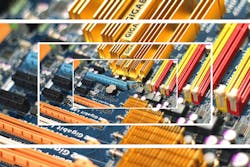Researchers Build Computer-on-a-Chip Prototype
Stanford researchers led an international team of engineers that figured out how to pack many functions of a computer onto a single chip, including processing circuits, memory storage, and a power supply. The prototype’s data processing and memory circuits use less than a tenth as much electricity as comparable electronic devices, yet still perform many advanced computing feats.
The prototype is built around data storage technology called resistive random-access memory (RRAM), which can pack more data into less space than any other form of memory and retains data when the chip hibernates—an energy-saving tactic built into the chip. It is also energy-efficient, so as to not overtax power supplies.
RRAM can also be built atop a processing circuit to combine data storage and computation into a single chip. This adds more energy efficiency and speeds processing.
To improve the storage capacity of RRAM, the Stanford team increased how much information each storage unit, or cell, holds. Memory devices typically consist of cells that store a zero or a one. The researchers devised a way to pack five values into each cell rather than just the two standard options.
As data is continuously written to a chip’s memory cells, they can wear down, scrambling data and causing errors. So the researchers developed an algorithm to prevent such exhaustion. Test show that the algorithm gave their prototype’s memory a 10-year lifespan.
The current prototype is about the diameter of a pencil, still too large for futuristic IoT applications, but the way the prototype combines memory and processing could be incorporated into chips for smartphones and other mobile devices. In fact, chipmakers are showing interest in this new architecture, which was one of the Stanford team’s goals.

